Why
Tellington Touch and agility make great partners...
 Two
jumps appear in the garden and suddenly three dogs appear, their attention focused on their
owners' every move. They are just waiting for some indication that a game is about to start.
All three dogs enjoy agility; all are or have been successful in the sport. But where does
'success' come from and how is it maintained? Correct training is essential, but so is taking
your dogs physical and mental welfare into account at all times. Jeanette Atkinson,
Godmanchester DTC instructor and Tellington Touch Companion Animal Practitioner, explains how
TTouch has helped her dogs. Two
jumps appear in the garden and suddenly three dogs appear, their attention focused on their
owners' every move. They are just waiting for some indication that a game is about to start.
All three dogs enjoy agility; all are or have been successful in the sport. But where does
'success' come from and how is it maintained? Correct training is essential, but so is taking
your dogs physical and mental welfare into account at all times. Jeanette Atkinson,
Godmanchester DTC instructor and Tellington Touch Companion Animal Practitioner, explains how
TTouch has helped her dogs.
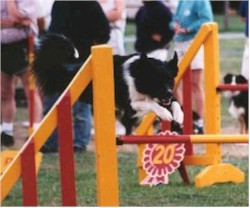 Our
dogs, like yours, are all highly individual and the demands of agility affect each one very
differently. Our
dogs, like yours, are all highly individual and the demands of agility affect each one very
differently.
-
Barney,
pictured right at Malvern in the 1994 Pedigree Novice Finals, is our retired Senior dog. He's
had a long agility career of over eight years. He is now 13 years old with an injury to a
back leg and some mental depression due to the loss of his beloved agility career.
-
Bess,
at six years, has always been limited in her ability due to a back injury sustained when very
young. But her confidence has improved so much that she will shoot around mini height
equipment with some enthusiasm.
-
Billy
is four and has had some minor successes due to his rampant enthusiasm for the game. We hope
to improve on his success if we can contain his emotional excitability.
All three dogs differ physically and
emotionally. They have totally different personalities and physical resources, and this
realisation was where my TTouch journey began some five years ago. Linda Tellington-Jones' book
came off the shelf and I started to experiment.
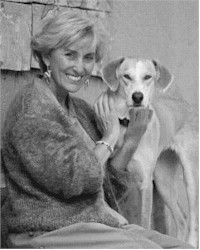 What
is TTouch? What
is TTouch?
TTouch is a method of working with animals that was developed by Linda
Tellington-Jones as a result of her experience of training to be a Feldenkrais
practitioner. As an experienced horsewoman she realised that some of the rehabilitation
exercises linking body and mind that were used with people in the Feldenkrais technique could
be used to help animals too. She found that an animal’s posture influences its behaviour and
that physical, mental and emotional balance are inextricably linked. The combination of TTouch
ground exercises and bodywork improves concentration, co-ordination and athletic ability in
many animals and is used widely around the world by trainers, pet owners and veterinarians.
Tom Beckett,
an American vet, who is actively involved in the Humane Society of Austin Travis County, Texas,
writes; ‘...with continued exposure to TTEAM (Tellington Touch Every Animal Method) animals
develop more ability to operate in a calm, focused mode. The animal learns to learn. This along
with more body awareness and awareness of environment yields more adaptability, more
appropriate action.’ Linda’s method is very broad and includes a range of techniques that can
be adapted to suit many situations/dogs. Most of all the method is always individualised to
each animal in its current situation and once you have tried it the potential for change is in
your hands.
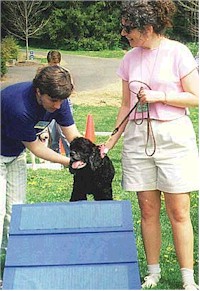 How
can TTouch benefit agility dogs? How
can TTouch benefit agility dogs?
This is easy to answer from my perspective
of over ten years of instructing and training my own dogs. TTouch can help to increase
confidence, concentration and co-ordination during training and competition. It can help to
keep a dog calm and focused but alert. In addition to this, consider that we often don’t warm
our dogs up before they are expected to run a course. We may not adequately consider their
physical/emotional needs after a heavy days’ competition and we may not help our retired dogs
to adjust to a different lifestyle?
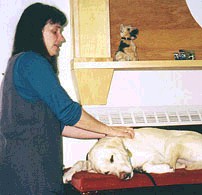 Dogs
are exceptional athletes. Of this there is no doubt, but injuries can occur when dogs are not
warmed up before they start to compete. More of a problem is that some older dogs may not be
able to make jump heights with ease. They need a good blood supply in their legs and feet so
that muscles can work effectively. If you stand at the ringside or in training and watch the
experienced handlers you will notice that they may, gently, run their hands over their dog’s
legs, tail or ears. TTouch offers ‘Python Lifts’. These are a very specific set of small lifts
that can be used down the legs to improve the blood flow to the extremities. It is my
experience that such lifts as well as the activating TTouches called ‘zig zags’ and the
‘octopus’ can be invaluable in preparing a dog for rapid action. Dogs
are exceptional athletes. Of this there is no doubt, but injuries can occur when dogs are not
warmed up before they start to compete. More of a problem is that some older dogs may not be
able to make jump heights with ease. They need a good blood supply in their legs and feet so
that muscles can work effectively. If you stand at the ringside or in training and watch the
experienced handlers you will notice that they may, gently, run their hands over their dog’s
legs, tail or ears. TTouch offers ‘Python Lifts’. These are a very specific set of small lifts
that can be used down the legs to improve the blood flow to the extremities. It is my
experience that such lifts as well as the activating TTouches called ‘zig zags’ and the
‘octopus’ can be invaluable in preparing a dog for rapid action.
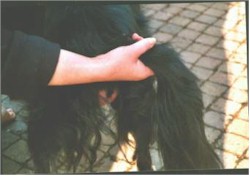 TTouch
to calm, focus and aid recovery TTouch
to calm, focus and aid recovery
How do you feel after a long training day or day at a show? My
dogs are often shattered mentally and sometimes physically. For our older two dogs some TTouch
before they sleep means that they settle rapidly and are not stiff the next day. They both come
and ‘request’ some TTouch. Often this is work on the tail which releases any tension in the
spine and pelvic region.
They enjoy general work on the body using
the ‘Leopard’ touches and some light ear work, which is useful to reduce any overall stress and
tension. Bess will request mouth work if she is tense by placing her mouth over my fingers.
Small light circles made with fingertips on her gums relax her jaw and she enjoys the
sensation.
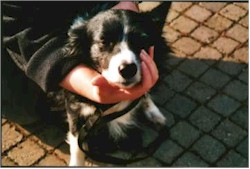 Our
young dog, Billy, will throw himself around courses with no respect for the equipment or any
damage that he may do to himself. He often needs specific TTouch (‘light ‘racoon’ touches on
his feet) to focus him before he enters the ring and to overcome potential injury. Our
young dog, Billy, will throw himself around courses with no respect for the equipment or any
damage that he may do to himself. He often needs specific TTouch (‘light ‘racoon’ touches on
his feet) to focus him before he enters the ring and to overcome potential injury.
In the winter he breasted a tyre so hard
that he winded himself for a few minutes and was physically collapsed. At home later he was
wrapped in elasticated bandages (a body wrap) to settle him quickly, and he slept for 14 hours
after a short session of ear work to reduce the effects of shock. The following morning he had
two sessions of TTouch specifically aimed at minimising any possible damage to his shoulders
and back and reducing any muscle memory of the impact. Happily and surprisingly, he was back to
normal within 24 hours. His 'normal' included jumping through tyres at supersonic speed.
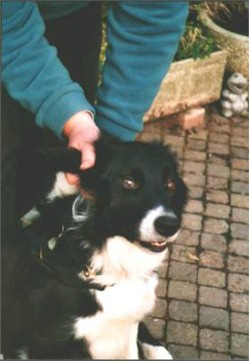 What
about our retired dogs that have worked so hard and often have the injuries to show for it?
Barney has a bony outgrowth in the knee of one hind leg, which our vet believes could have been
due to a shear stress injury when turning at speed. He now holds this back leg out at an angle,
or he used to. Following comments from one of the TTouch practitioners in the US that she used
specific body wraps to improve the posture of her show dogs to great effect, I decided to
attempt a postural adjustment with Barney. My intention was to reduce the pressure on the good
leg and his hips that was caused by the shift in weight from the injured leg. What a surprise!
After a few body wraps that reconnected both hips, I can see that the back left leg doesn’t
turn out any more. At some point I will have to get another X-ray to see if the visible damage
in the joint is still the same. What
about our retired dogs that have worked so hard and often have the injuries to show for it?
Barney has a bony outgrowth in the knee of one hind leg, which our vet believes could have been
due to a shear stress injury when turning at speed. He now holds this back leg out at an angle,
or he used to. Following comments from one of the TTouch practitioners in the US that she used
specific body wraps to improve the posture of her show dogs to great effect, I decided to
attempt a postural adjustment with Barney. My intention was to reduce the pressure on the good
leg and his hips that was caused by the shift in weight from the injured leg. What a surprise!
After a few body wraps that reconnected both hips, I can see that the back left leg doesn’t
turn out any more. At some point I will have to get another X-ray to see if the visible damage
in the joint is still the same.
TTouch for agility
TTouch can help you to be successful in agility whether you just need to be able to ready your
dog for the ring, make your dog comfortable after competition or settle your retired dog. I
have found the depth and breadth of the method invaluable in the full range of canine
activities in which I am involved. A few examples of TTouch success include:-
-
Some cases of intermittent, non-specific lameness have been solved.
-
A
dog that was bringing poles down has been helped to find more accuracy.
-
Basic ground exercises have been used to improve co-ordination in young dogs before
commencing agility exercises.
-
The labyrinth ground exercise has been used to teach flexibility in turns before progressing
this to the equipment
-
Body wraps have been used to calm excitable dogs.
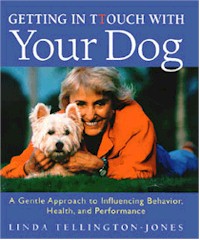 More
and more I find myself instinctively using TTouch to improve performance, reduce the risk of
injury and alleviate signs of physical and emotional distress before, during and after agility.
Linda’s new book Getting in TTouch with Your
Dog (2001) is worth a read. More
and more I find myself instinctively using TTouch to improve performance, reduce the risk of
injury and alleviate signs of physical and emotional distress before, during and after agility.
Linda’s new book Getting in TTouch with Your
Dog (2001) is worth a read.
If you would like more information about how TTouch can help
your canine agility partner, contact Sarah Fisher on 01761-471182 or email
sarahfisher@tteam.co.uk.
If you would like a one-to-one consultation, a
list of certified UK TTouch practitioners, who have completed a three-year training course, is
available from Sarah. Workshops can be arranged on request. If you would be interested in a
workshop, then please send a stamped addressed envelope marked ‘Agility Workshop’ to Sarah
Fisher,
Tilley Farm, Farmborough, nr. Bath, Somerset
BA2 0AB
About the author...
Jeanette Atkinson BSc, Dip Pharm is owner/manager of HealthGen, a small consultancy
specialising in health technology assessment. Living and working from Little Staughton in
Bedfordshire, all her leisure time is filled with animals.
She
is a member of Godmanchester DTC, based at Wood Green Animal Shelters, where she instructs on a
weekly basis. She has taught agility for the last eight years and basic pet training (including
puppies) for the last two years. Husband Paul now partners Billy in agility, having had some
success with two other dogs over the last 12 years - Jim, the Golden Retriever who was nine
when he started agility and retired at 15! and Barney, a working sheep dog, made Senior
level but is now retired.
Jeanette is a Tellington TTouch practitioner, a methodology which she finds increasingly
valuable when mixed with other training modalities/tools at all stages of an animal's life and
in many day-to-day situations.
Anyone who wants to contact Jeanette direct
can do so on jeanette@healthgen.co.uk. She is
happy to do one-to-one consultations or groups.
Sarah Fisher
trained with Linda Tellington Jones and Robyn Hood in the U.S.A. and is the UK's highest
qualified Equine and Companion Animal Practitioner.
She runs the UK office
for TTEAM & TTouch International, writes for national magazines and teaches one and two day
workshops as well as working with private clients. Sarah works for the Bath Cats and Dogs Home
and teaches staff workshops for many national animal charities including Wood Green, National
Canine Defence League and the Thoroughbred Rehabilitation Centre.
Sarah lives near Bath
where she runs a teaching Centre for TTEAM and TTouch.
For
further information contact:
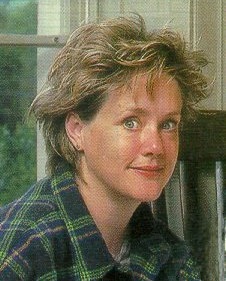
Sarah Fisher
Tilley Farm, Farmborough, nr Bath, Somerset BA2 0AB
Tel: 07968 006529 email: sarahfisher@tteam.co.uk
http://www3.sympatico.ca/tilleyfarm/
Postscript
Just for interest, one
of the Best in Show dogs (Picasso - the black standard Schnauzer) belongs to a TTouch
practitioner-trained person; Alberto Alvarez. Picasso is a great dog and is maintained at peak
performance for the show ring. (11/03/02)
Personal experience
Having bought the book a while ago and have been
using this method a little on my older Golden Retriever, I wanted to learn more. Jeanette came
to our dog training club (Huntingdon DTC) last Monday and gave us a talk and brief demo, and it
was very interesting. Most of those present wanted to learn more, and Jeanette has offered to
organise a workshop for us in the future. (14/03/02)
Photos: Jeanette Atkinson and
Cascade Animal Connection
Feedback
From Anne Redding
I have used TTouch on my two year old dog, a little while he
was still training in agility and more recently after he lost the lower half of one of his back
legs in an accident.
Since his accident TTouch has helped him get
his confidence and balance back far quicker than I could ever have imagined.
We had one session with his agility trainer,
Barbara Cooper and another practitioner whom I think it was Jeanette Atkinson who wrote this
article, as she had more experience with amputees. The rest of his TTouch has been done by me.
I would recommend TTouch to any dog
owner. I've got the lovely little doggie personality back that I had before his accident.
(06/11/02)
|